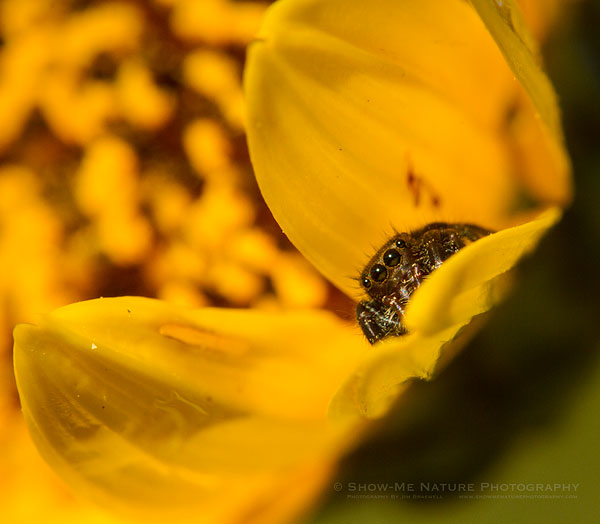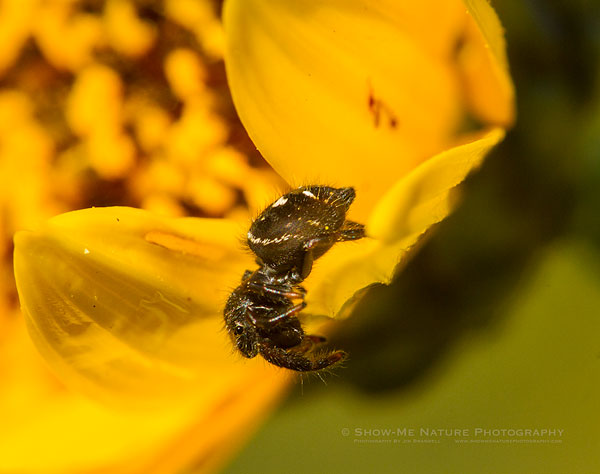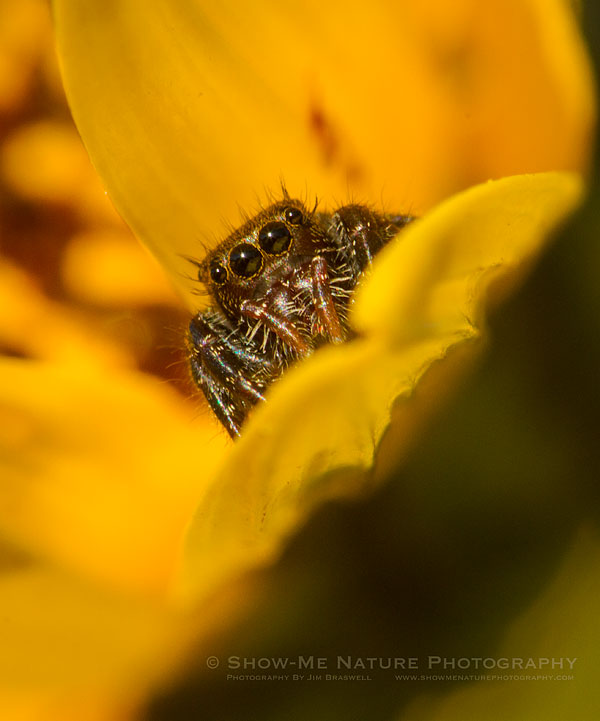Warning to Arachnaphobics: This Post Contains Images of a Spider!!!
To buy some time and space, so our arachnaphobic friends do not see my spider friend, I’ll first share some interesting information on them.
Today’s post features a few images I captured of a small, White-spotted Jumping Spider (Phidippusaudax) that was partially hidden in a wildflower bloom, taken about 3 weeks ago. During my prairie hikes, particularly in late summer and early fall, I have occasionally found these small spiders, usually partially hidden inside a wildflower bloom. As with many spiders, the females tend to be a bit larger than their male counterpart, 8-15mm long for the females and 6-12mm for the males. All jumping spiders have a flattened eye region, with two large eyes set close together among six other, smaller eyes … talk about having “eyes in the back of your head!”. The jumping spiders have the sharpest vision of all spiders, and are excellent hunters. They demand a lot of their sense of sight, not only for hunting, but for courting. For this reason, many jumping spiders have iridescent markings or colors on their bodies, making them more “visible” to potential mates.
Preferred prey of these little guys are bugs, caterpillars and other spiders. The large family of jumping spiders gets it’s name from the spectacular leaps that the spiders make while pouncing on their prey. As the spider pounces on prey, silk comes out from the spinnerets (which are silk spinning structures), creating a long, silken dragline. The jumping spiders do not spin a web, but make little, silken shelters under bark, stones, or leaves.
My trek on this day was no different than previous encounters with the jumping spider. As I neared the end of my hike, I saw this small little head peering over the edge of a wildflower petal, apparently watching my every move with much interest:
He was not too concerned with my presence, but shooting with my 180mm macro lens + 1.4x TC allowed me to shoot without getting so close as to frighten him away (note: 6 of his 8 eyes are visible in the following photo … can you find them?):
At one point, he moved a bit and appeared to be looking below the plant, or maybe under the petal of the wildflower. In this next photo, you can readily see the white spots on his back, as well as the spinneret (the pointed portion, at the rear of his abdomen):
After not finding anything there, he moved back to his original position and again took up “people watching”. In this final image, note that you can see the iridescent green color on the legs to the left side of the photo:
These little spiders are always fun to photograph … and I still find it hard to believe that they have 8 eyes on me as I photograph them!
Photo Equipment Used:
- Canon 7D body
- Canon 180mm macro lens + Canon 1.4x TC (totally 252mm)
- Bogen 3221 Tripod, with Kirk Ent. HD ballhead
- ISO 400
- Aperture f/16
- Shutter Speed 1/6o sec. to 1/100 sec.













